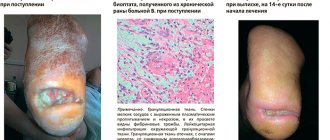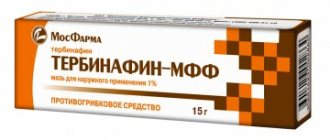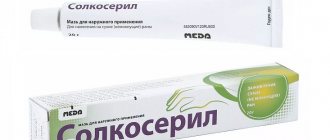Actovegin 200 mg 50 pcs. film-coated tablets
Composition and release form Actovegin 200 mg 50 pcs. film-coated tablets
Tablets - 1 tablet.
contains blood components: deproteinized hemoderivative of calf blood 200.0 mg, in the form of Atovegin® granulate* 345.0 mg. *Actovegin® granulate contains:
- active substance: blood components: deproteinized hemoderivative of calf blood - 200.0 mg;
- excipients: povidone-K 90 - 10.0 mg, microcrystalline cellulose - 135.0 mg.
- Excipients: magnesium stearate - 2.0 mg, talc - 3.0 mg.
- Shell composition: acacia gum - 6.8 mg, mountain glycol wax - 0.1 mg, hypromellose phthalate - 29.45 mg, diethyl phthalate - 11.8 mg, quinoline yellow aluminum varnish dye - 2.0 mg, macrogol-6000 - 2.95 mg, povidone-K 30 - 1.54 mg , sucrose - 52.3 mg, talc - 42.2 mg, titanium dioxide - 0.86 mg.
50 pcs. - dark glass bottles (1) - cardboard packs.
Description of the dosage form
Greenish-yellow film-coated tablets, shiny, round, biconvex.
Directions for use and doses
Dosage and method of use of Actovegin
depend on the nosological form and severity of the disease. 1-2 tablets are prescribed orally 3 times a day before meals. Do not chew the pills, wash them down with a small amount of water. For intravenous or intravenous administration, depending on the severity of the disease, the initial dose of the drug in the form of an injection solution is 10-20 ml. Then prescribe 5 ml IV slowly or IM 1 time/day daily or several times a week.
A solution for infusion with sodium chloride 20%, a solution for infusion with sodium chloride 10%, a solution for infusion 10% with dextrose is administered intravenously by drip or intravenous injection.
In case of disorders of blood supply and metabolism of the brain, initially 250-500 ml/day is administered intravenously for 2 weeks, then 250 ml intravenously several times a week for at least 4 weeks.
For ischemic stroke, 250-500 ml is administered intravenously daily or several times a week for about 2-3 weeks.
For arterial angiopathy, 250 ml is administered intravenously and intravenously daily or several times a week; Duration of therapy is about 4 weeks.
For trophic and other indolent ulcers and burns, 250 ml is administered intravenously daily or several times a week, depending on the speed of healing, in addition to local therapy with Actovegin
. In order to prevent and treat radiation damage to the skin and mucous membranes, an average of 250 ml is administered intravenously the day before and daily during radiation therapy, as well as for 2 weeks after its completion.
Rules for administering solutions Actovegin solutions for infusion with sodium chloride 20% and 10% and with dextrose 10% are intended for intravenous drip or intravenous jet administration.
Before starting Actovegin infusion, you must ensure the integrity of the bottle. The solution for infusion is administered in a dose of 250 ml. The initial dose can be increased to 500 ml. The infusion rate is approximately 2 ml/min. 10-20 infusions may be required to achieve the desired effect. During infusion, care must be taken to ensure that the solution does not enter extravascular tissue.
Indications for use Actovegin 200 mg 50 pcs. film-coated tablets
- Trophic ulcers;
- bedsores;
- slow-healing wounds;
- cerebrovascular accidents;
- traumatic brain injuries;
- complications of varicose veins of the lower extremities;
- burns;
- corneal damage.
Contraindications
hypersensitivity to the drug Actovegin
.
Application Actovegin 200 mg 50 pcs. film-coated tablets during pregnancy and breastfeeding
It is possible to use the drug Actovegin
orally or parenterally during pregnancy and lactation as indicated.
special instructions
If allergic reactions occur, treatment is stopped. Inject slowly and not more than 5 ml intramuscularly (the solution has hypertonic properties). With repeated infusions, indicators of water and electrolyte metabolism are monitored. The infusion solution has a slightly yellowish tint, the intensity of which depends on the batch number and the starting material, but the color of the solution does not affect the effectiveness or tolerability of the drug. After opening the bottle, the solution cannot be stored. It is not permissible to use the stored solution. You cannot add any medications to the Actovegin® infusion solution due to possible pharmaceutical incompatibility. As with all other drugs intended for parenteral administration, before infusion of the Actovegin® solution, you must ensure that the vial is intact.
Actovegin 20% 20g gel for external use
Composition and release form Actovegin 20% 20g gel for external use
Solution for infusion (in dextrose solution) - 250 ml active substance: deproteinized hemoderivative of calf blood - 25 ml (corresponds to 1 g of dry weight) excipients: dextrose; sodium chloride; water for injection in 250 ml bottles; 1 bottle in a cardboard pack. Solution for infusion (in sodium chloride solution 0.9%) - 250 ml active substance: deproteinized calf blood hemoderivate - 25 ml (corresponds to 1 g of dry weight) - 50 ml (corresponds to 2 g of dry weight) excipients: sodium chloride; water for injection in 250 ml bottles; 1 bottle in a cardboard pack.
Directions for use and doses
Dosage and method of use of Actovegin
depend on the nosological form and severity of the disease. 1-2 tablets are prescribed orally 3 times a day before meals. Do not chew the pills, wash them down with a small amount of water. For intravenous or intravenous administration, depending on the severity of the disease, the initial dose of the drug in the form of an injection solution is 10-20 ml. Then prescribe 5 ml IV slowly or IM 1 time/day daily or several times a week.
A solution for infusion with sodium chloride 20%, a solution for infusion with sodium chloride 10%, a solution for infusion 10% with dextrose is administered intravenously by drip or intravenous injection.
In case of disorders of blood supply and metabolism of the brain, initially 250-500 ml/day is administered intravenously for 2 weeks, then 250 ml intravenously several times a week for at least 4 weeks.
For ischemic stroke, 250-500 ml is administered intravenously daily or several times a week for about 2-3 weeks.
For arterial angiopathy, 250 ml is administered intravenously and intravenously daily or several times a week; Duration of therapy is about 4 weeks.
For trophic and other indolent ulcers and burns, 250 ml is administered intravenously daily or several times a week, depending on the speed of healing, in addition to local therapy with Actovegin
. In order to prevent and treat radiation damage to the skin and mucous membranes, an average of 250 ml is administered intravenously the day before and daily during radiation therapy, as well as for 2 weeks after its completion.
Rules for administering solutions Actovegin solutions for infusion with sodium chloride 20% and 10% and with dextrose 10% are intended for intravenous drip or intravenous jet administration.
Before starting Actovegin infusion, you must ensure the integrity of the bottle. The solution for infusion is administered in a dose of 250 ml. The initial dose can be increased to 500 ml. The infusion rate is approximately 2 ml/min. 10-20 infusions may be required to achieve the desired effect. During infusion, care must be taken to ensure that the solution does not enter extravascular tissue.
Indications for use Actovegin 20% 20g gel for external use
- Trophic ulcers;
- bedsores;
- slow-healing wounds;
- cerebrovascular accidents;
- traumatic brain injuries;
- complications of varicose veins of the lower extremities;
- burns;
- corneal damage.
Contraindications
hypersensitivity to the drug Actovegin
.
Application of Actovegin 20% 20g gel for external use during pregnancy and breastfeeding
It is possible to use the drug Actovegin
orally or parenterally during pregnancy and lactation as indicated.
special instructions
If allergic reactions occur, treatment is stopped. Inject slowly and not more than 5 ml intramuscularly (the solution has hypertonic properties). With repeated infusions, indicators of water and electrolyte metabolism are monitored. The infusion solution has a slightly yellowish tint, the intensity of which depends on the batch number and the starting material, but the color of the solution does not affect the effectiveness or tolerability of the drug. After opening the bottle, the solution cannot be stored. It is not permissible to use the stored solution. You cannot add any medications to the Actovegin® infusion solution due to possible pharmaceutical incompatibility. As with all other drugs intended for parenteral administration, before infusion of the Actovegin® solution, you must ensure that the vial is intact.








